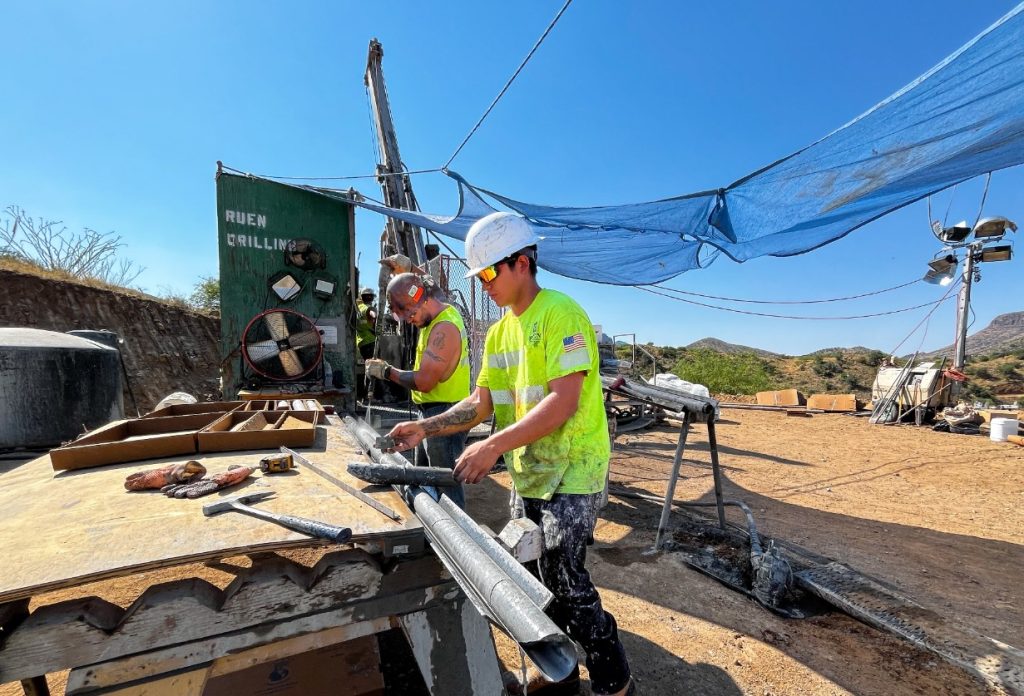Faraday Copper drills 1.31% copper over 22.65 metres within 50.20 metres at 0.74% copper at Banjo Breccia, Arizona

Faraday Copper Corp. [TSX: FDY; OTCQX: CPPKF] provided an exploration update and announced the results of one drill hole from its ongoing Phase III drill program at the Copper Creek Project, located in Arizona. The hole was drilled to evaluate the near-surface mineralization above the recently discovered Banjo breccia in the American Eagle area.
Paul Harbidge, President and CEO, commented, “It is very exciting that this result further delineates the recently discovered Banjo breccia and now outlines 400 vertical metres of mineralization from the surface outcrop. The nature of mineralization in this hole suggests significant concentration of copper through supergene enrichment. To date, approximately 75% of our Phase III drilling has been focused on the discovery of additional near-surface mineralization outside the resource area to further unlock the potential scale of the project.”
Highlights: At the Banjo breccia, drill hole FCD-24-074 intersected 22.65 metres at 1.31% copper within 50.20 metres at 0.74% copper from 46.20 metres.
This hole, together with previous drilling, and surface geological mapping demonstrates that mineralization at Banjo extends from surface to 400 metres depth and remains open.
Copper Creek boasts significant exploration upside with several new high priority targets being drill tested, including: The Rum area features porphyry-hosted copper oxide mineralization at surface and several breccias over an area of approximately 250 m by 400 m, located 700 m north of the resource area. The American Eagle area hosts numerous untested breccias with anomalous copper at surface and drilling is currently focused on further delineating mineralization and testing new breccia targets.
The American Eagle area as mapped on surface, covers approximately 800 m by 1,000 m and is host to numerous prospective breccias and porphyries which have strong copper geochemical signatures. These surface expressions are above the large underground porphyry mineral resource, which is approximately 500 m to 1,100 m depth below surface. Historically, the near-surface mineralization was not adequately tested as previous drilling was vertical to steeply inclined. Mapped geology, isolated historical drill intercepts and historical small-scale mining highlight the potential for near-surface mineralization. The company has reported assay results for 11 drill holes from this area as part of the current program.
These results provide a broad framework of the geology, structure, and alteration and confirm the potential for significant near-surface copper mineralization. Drilling continues in the area to test additional previously undrilled breccias including the Courthouse, Jailhouse, Post Office and Giuseppe breccias. Follow-up drilling is planned at Prada, American Eagle and Banjo breccias.
A detailed district-scale geological map has been compiled using new and historical information. This, together with geophysical data, formed the basis of a refined model for the structural evolution of the district which, in turn, supports exploration targeting and prioritization.
Thirty-four targets have been identified, ranging from early conceptual to mineral resource targets. In addition to drilling in the American Eagle area, drilling has commenced in the Rum area, which is located approximately 700 m northwest of the resource. Rum includes porphyry with copper oxide mineralization and hydrothermal breccias exposed over an area of 250 m to 400 m.
Phase III drilling continues with the current focus on near-surface mineralization in the American Eagle and Rum areas.
To date, through the combined Phase II and Phase III drill programs, which are not included in the Mineral Resource Estimate, the Company has released results from 65 drill holes as follows: 38 drill holes were drilled on new targets that are entirely outside of the resource boundary; 20 drill holes were step-out holes testing extensions to the mineral resource; and seven drill holes were drilled within the resource area, targeting expansion of the higher-grade cores.
The company expects to include over 30,000 metres of incremental drilling to the resource update planned for 2025, with the new targets representing a significant opportunity to enhance the project value.
